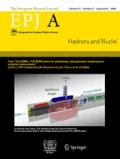Abstract
We propose a general method for the description of arbitrary single spin-j states transforming according to (j, 0) ⊕ (0, j) carrier spaces of the Lorentz algebra in terms of Lorentz tensors for bosons, and tensor-spinors for fermions, and by means of second-order Lagrangians. The method allows to avoid the cumbersome matrix calculus and higher ∂2j order wave equations inherent to the Weinberg-Joos approach. We start with reducible Lorentz tensor (tensor-spinor) representation spaces hosting one sole (j, 0) ⊕ (0, j) irreducible sector and design there a representation reduction algorithm based on one of the Casimir invariants of the Lorentz algebra. This algorithm allows us to separate neatly the pure spin-j sector of interest from the rest, while preserving the separate Lorentz and Dirac indexes. However, the Lorentz invariants are momentum independent and do not provide wave equations. Genuine wave equations are obtained by conditioning the Lorentz tensors under consideration to satisfy the Klein-Gordon equation. In so doing, one always ends up with wave equations and associated Lagrangians that are of second order in the momenta. Specifically, a spin-3/2 particle transforming as (3/2, 0) ⊕ (0, 3/2) is comfortably described by a second-order Lagrangian in the basis of the totally anti-symmetric Lorentz tensor-spinor of second rank, Ψ [μν]. Moreover, the particle is shown to propagate causally within an electromagnetic background. In our study of (3/2, 0) ⊕ (0, 3/2) as part of Ψ [μν] we reproduce the electromagnetic multipole moments known from the Weinberg-Joos theory. We also find a Compton differential cross-section that satisfies unitarity in forward direction. The suggested tensor calculus presents itself very computer friendly with respect to the symbolic software FeynCalc.
Similar content being viewed by others
References
S. Weinberg, The Quantum Theory of Fields, Vol. 1, Foundations (Cambridge University Press, Cambridge, 1995).
S. Weinberg, Phys. Rev. B 133, 1318 (1964).
H. Joos, Fortsch. Phys. 10, 65 (1962).
A. Sankaranarayanan, Nuovo Cimento A 56, 459 (1968) DOI:10.1007/BF02753103.
J.O. Eeg, Lett. Nuovo Cimento 13, 14 (1975).
J.O. Eeg, Phys. Nor. 8, 137 (1976).
W. Rarita, J. Schwinger, Phys. Rev. 60, 61 (1941).
G. Velo, D. Zwanziger, Phys. Rev. 188, 2218 (1969).
S. Ferrara, M. Porrati, V. Telegdi, Phys. Rev. D 46, 3529 (1992).
L.C. Hostler, J. Math. Phys. 26, 1348 (1985).
A. Morgan, Phys. Lett. B 351, 249 (1995).
C.A. Vaquera-Araujo, JHEP 07, 049 (2013).
C.A. Vaquera-Araujo, M. Napsuciale, R. Angeles-Martinez, JHEP 01, 011 (2013).
M. Napsuciale, M. Kirchbach, S. Rodriguez, Eur. Phys. J. A 29, 289 (2006).
E.G. Delgado-Acosta, M. Napsuciale, Phys. Rev. D 80, 054002 (2009).
E.G. Delgado-Acosta, M. Kirchbach, M. Napsuciale, S. Rodriguez, Phys. Rev. D 85, 116006 (2012).
E.G. Delgado-Acosta, M. Kirchbach, M. Napsuciale, S. Rodríguez, Phys. Rev. D 87, 096010 (2013).
Brain G. Wyborne, Group theory for physicists (Wiley & Sons, N.Y., 1974).
Ch. Schubert, AIP Conf. Proc. 917, 178 (2007).
Johnny Espin, Kirill Krasnov, arXiv:1308.1278 [hep-th].
E.G. Delgado-Acosta, M. Napsuciale, S. Rodriguez, Phys. Rev. D 83, 073001 (2011).
J. Niederle, A.G. Nikitin, Phys. Rev. D 64, 125013 (2001).
D.V. Ahluwalia, N. Dadich, M. Kirchbach, Int. J. Mod. Phys. D 11, 1621 (2002).
D.V. Ahluwalia, M. Kirchbach, Mod. Phys. Lett. A 16, 1377 (2001).
M. Kirchbach, D.V. Ahluwalia, Phys. Lett. B 529, 124 (2002).
C. Lorcé, Phys. Rev. D 79, 113011 (2009).
J.D. Bjorken, S.D. Drell, Relativistic Quantum Mechanics (McGraw-Hill, New York, 1998).
P. Van Nieuwenhuizen, Phys. Rep. 68, 189 (1981).
Author information
Authors and Affiliations
Corresponding author
Additional information
Communicated by R. Alkofer
Rights and permissions
About this article
Cite this article
Delgado Acosta, E.G., Banda Guzmán, V.M. & Kirchbach, M. Bosonic and fermionic Weinberg-Joos (j,0) ⊕ (0,j) states of arbitrary spins as Lorentz tensors or tensor-spinors and second-order theory. Eur. Phys. J. A 51, 35 (2015). https://doi.org/10.1140/epja/i2015-15035-x
Received:
Revised:
Accepted:
Published:
DOI: https://doi.org/10.1140/epja/i2015-15035-x


